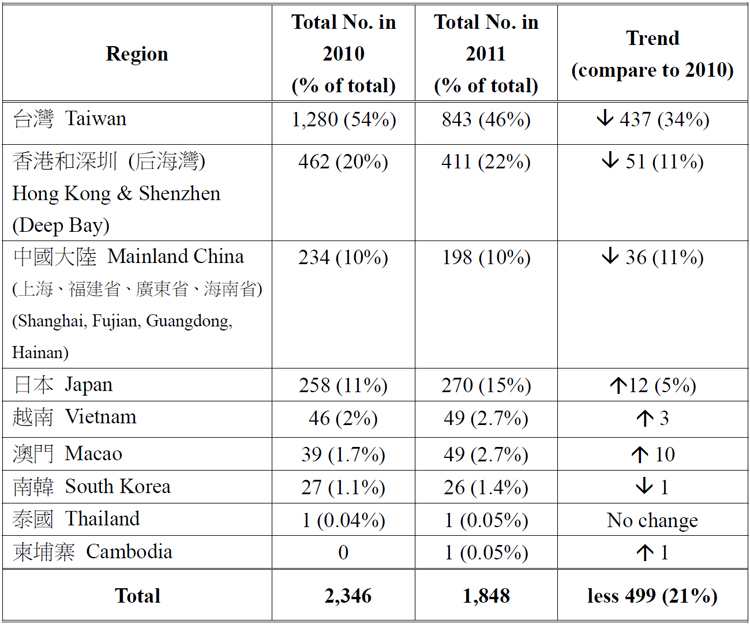International Black-faced Spoonbill Census 2011
Hong Kong Bird Watching Society
30 Mar 2011
Black-faced Spoonbill, a globally endangered species, occurs on the eastern fringe of Asia. In the last decade, the number of Black-faced Spoonbills has been increasing. The world population count reached a record high of 2,346 in 2010. However, the international census conducted in January this year recorded only 1,848, a 21% decrease from last year. It is the biggest slump since the census started in 1993. The situation is worrying.
Mr. Yu Yat Tung, representing the Hong Kong Bird Watching Society, is the Coordinator of the International Census of Black-faced Spoonbill. He pointed out that the slump was mainly due to the 34% decrease of the Taiwanese population. Taiwan has always accounted for the largest share of the global wintering population. Over the past few years, the spoonbills were mainly concentrated at a few sites. According to this year’s findings, two key areas in Taiwan have accounted for 46% of the total number of Black-faced Spoonbill. Deep Bay (Hong Kong and Shenzhen) accounted for 22 %. These two regions have already shared 68% of the world’s population. In other words, any threats or catastrophic events at any of the above sites will seriously affect the existence of spoonbills.
In fact, Taiwan had recorded a large number of Black-faced Spoonbills in early winter but they were found missing during the census, making the count drop by 34% versus last year. Mainland China is also down by 15%. A relatively smaller decline, 11% over 2010, is recorded in Deep Bay (Hong Kong and Shenzhen). The numbers of spoonbill in Japan, Vietnam, Macau and Cambodia have increased slightly but are still far from sufficient to fill up the gap. According to last year’s information, no large die-off was recorded and we suspect that the decline may due to a persistently freezing cold winter. It may also be due to unsuccessful breeding in the preceding summer. The real cause is yet to be discovered.
Cambodia has joined the census this year. A Black-faced Spoonbill with a satellite-tracking device fitted in South Korea was found in that country before and after the census. It may show that the migratory birds were forced to move further south by the cold winter. Having said that, we were not able to track Black-faced Spoonbill in great numbers in southern Asia.
Black-faced Spoonbill is not only the wetland star in Hong Kong, it is the world's endangered bird species too. In order to protect this rare species, a number of conservation organizations and their governments in East Asia have worked together to protect the habitats of Black-faced Spoonbill since the nineties. In 1995, they developed a Program of Action, the first of its kind, to protect the spoonbills. They further amended the Program of Action in 2010, focusing on setting up more protected areas and carrying out more detailed investigation on breeding grounds, as well as strengthening the cooperation amongst regions.
Habitat destruction and degradation are still the imminent threats to conservation of Black-faced Spoonbill. Many coastal areas are surrounded by a variety of development projects in South Korea, Macau and Hainan. Illegal hunting still occurs in some of the sites. For example, 11 Black-faced Spoonbills were rescued from the hands of hunters in Vietnam during the last winter. Hong Kong's Deep Bay area is still plagued by huge development pressure. There is still a long way to go for the conservation of this species.
The Hong Kong Bird Watching Society began coordinating the Black-faced Spoonbill International Census in 2003. It has helped to improve our understanding of the needs of this Endangered species. This year the international census was conducted from 21st to 23rd January 2011 and the results are as follows:
spoonbills were recorded in 2011 census, a decrease of 499 in numbers or 21% versus 2010;
The largest wintering group is still in Taiwan. The total number is 843 or 46% of world’s population. Taiwan recorded the largest decline of all areas, a drop by 437 in numbers versus 2010;
411 spoonbills were recorded in Hong Kong and Shenzhen, which is 11 % down or 51 in number versus 2010. Last year’s count was 462.
Mainland Chinese coastal areas fell by 15%. Only 198 were recorded in 2011, decreased by 36 from last year’s total of 234.
A slight increase in Japan, Vietnam and Macau was not enough to fill the gap from Taiwan, Deep Bay and mainland China.
South Korea, Japan, Shanghai, Fujian, Guangdong, Hainan, Taiwan, Hong Kong, Shenzhen, Macau and Vietnam joined this year’s census. Cambodia is the latest addition to the census participants.
HKBWS would like to acknowledge all the organizations and volunteers involved in the census, without whom it would not have been completed successfully. We hope that continued international efforts can succeed in preserving the future of the Black-faced Spoonbill.




